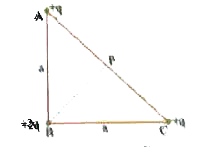The field lines for two point charges shown in fig.

(i) Is the field uniform?
(ii) Determine the ratio qA/qB.
(iii) What are the sign of qA and qB ?
(iv) Apart from infinity, where is the neutral point?
(v) If qA and qBare separated by a distance 10(√2−1) cm, find the position of neutral point.
(vi) where will the lines meet which are coming from A and are not meeting at qB?
(vii) Will a positive charge follow the line of force if free to move?
(i) No
(ii) The number of lines coming from or coming to a charge is proportial to the magnitude of the charge, so
qAqB=126=2
(iii) qA is positive and qB is negetive.
(iv) C is the other netual point.
(v) for neutral point
EA=EB⇒14πε0qA(l+x)2=14πε0qBx2
or, (l+xx)2=qAqB=2 or x=10cm
(vi) at infinity .
(vii) No, As lines of force are curved, the direction of velocity and acceleration will be different. Hence, a charge cannot follow strictly the lines of force. Also to move on some curved path, centripetal force is required. whereas the lines of force will provide only tangential force.

Topper's Solved these Questions
- BOOK - CENGAGE PHYSICSCHAPTER - COULOMB LAW AND ELECTRIC FIELDEXERCISE - Solved examples10videos
COULOMB LAW AND ELECTRIC FIELD
- BOOK - CENGAGE PHYSICSCHAPTER - COULOMB LAW AND ELECTRIC FIELDEXERCISE - Exercises58videos
COULOMB LAW AND ELECTRIC FIELD
- BOOK - CENGAGE PHYSICSCHAPTER - COMMUNICATION SYSTEMEXERCISE - QUESTION BANK19videos
COMMUNICATION SYSTEM
- BOOK - CENGAGE PHYSICSCHAPTER - Current ElectricityEXERCISE - QUESTION BANK40videos
Current Electricity
Similar Questions
Knowledge Check
- Question 1 - Select One
The positions of two point charges q1 and q2 are →r1 and →r2 , respectively. Find the position of the point where the net field is zero due to thses charges.
A→r1√q1+→r2√q2√q1+√q2B→r1√q2+→r2√q1√q1+√q2C→r1√q2+→r2√q1√q1+q2D→r1√q1+→r2√q2√q1+q2 - Question 2 - Select One
Two positive point charges q1=16μC and q2=4μC are separated in vacuum by a distance of 3.0m. Find the point on the line between the charges where the net electric field is zero.-
A2m from q1B1m from q1C2m from q2D0.5m from q1 - Question 3 - Select One
Two charge Q1=18μC and Q2=−2μC are separted by a distance R, and Q1 is on the left off Q2. The distance of the point where the net electric field is zero is
Abetween Q1 and Q2Bleft of Q1atR/2Cright of Q2 at RDright of Q2 at R/2
Consider the situation shown in (figure) what are the signs of q1 and q2 ? If the lines are drawn in proportion to the charge, what is the ratio q1q2 ?
 View Solution
View SolutionFigure shows the electirc field lines for two point charges separated by a distance. What are the signs of q1andq2 ? Can you determine the ratio q1∣q2 ?
 View Solution
View SolutionTwo point charges Q and −Q/4 are separated by a distance X. Then
 .View Solution
.View SolutionTwo point charges q1=+2C and q2=−1C are separated by a distance d. The position on the line joining the two charges where a third charge q=+1C will be in equilibrium is at a distance
View SolutionThree charges +q, +q, +2q are arranged as shown in figure. What is the field at point P (center of side AC)
 View Solution
View Solution


